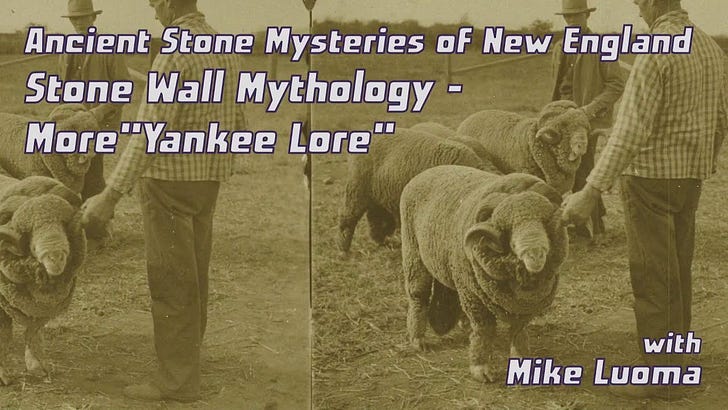Stone Wall Mythology - More "Yankee Lore"
A Video Transcript and More - Loaded with Bonus Content for Subscribers!
The following is a transcript for my new video, Ancient Stone Mysteries of New England: More “Yankee Lore” — Stone Wall Mythology, and also much more. You’ll find lots of Bonus Content here for subscribers — additional photos, raw footage, behind-the-scenes notes and material, and more. There’s a bunch before the paywall to make it worth it for Free Subscribers, and even more beyond for you Paid Subscribers who help support my work. Thank you!
“Something there is that doesn't love a wall…” poet Robert Frost wrote in Mending Wall. Great poem. San-Francisco-born Frost is one of Yankee Lore’s premier mythologists. His mythical, mostly made-up, New England continues to appeal to the descendants of Yankee settlers, as he echoes family lore and legends, casting them in a nostalgic golden light – the anecdotal given poetic authenticity.
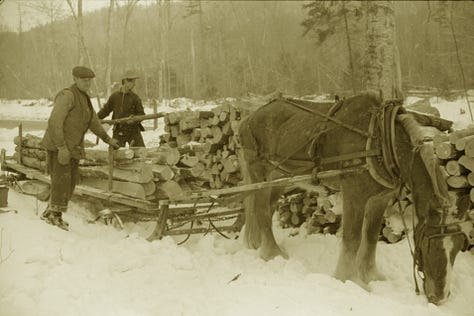
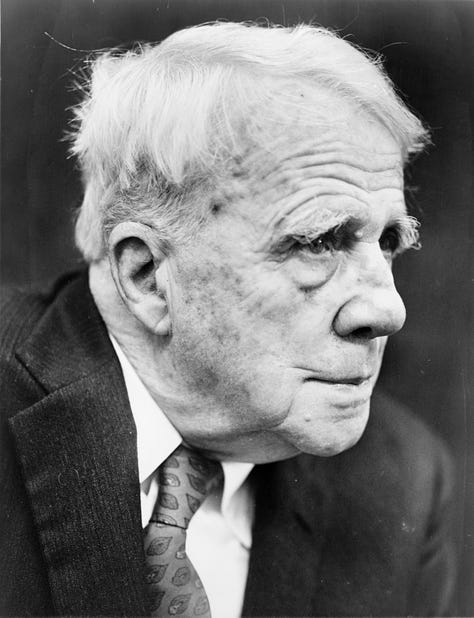
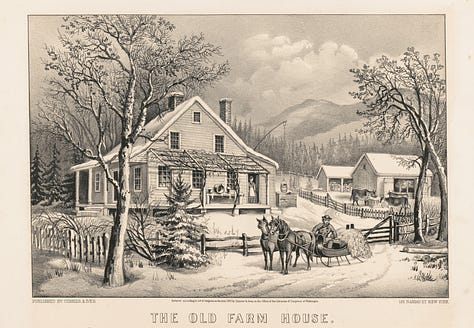
But it's not real. It just feels real. City boy Frost's assumptions on stone wall building and country and rural life in general still capture the country's cultural imagination. Frost is the poet laureate of Yankee Lore.
We're now so far removed from those early days, that way of life, that folks take Frost's romantic representations for facts, but they’re fiction. Which would be fine, except some authorities have fashioned historical preservation policy based on those myths. And some have embraced Frost and the legends of industrious farmers creating hundreds of thousands of miles of stone walls in New England – in an unbelievably short time – in order to deny that the stonework of New England could have any other origin.
Something there is that doesn't love a wall…
Bonus Content: A slightly longer look at this Enclosure Feature in North Stonington, Connecticut, seen briefly near the beginning of the published More “Yankee Lore video.
As I look into our ancient stone mysteries of New England, it's surprising to discover the degree to which Yankee Lore informs even New England's official archeology, as too many State Historic Preservation authorities and archeologists insist there is no basis to attribute New England stonework to anyone but colonial settlers or later sheep farmers.
These authorities give Yankee Lore a scientistic authority it has not earned.
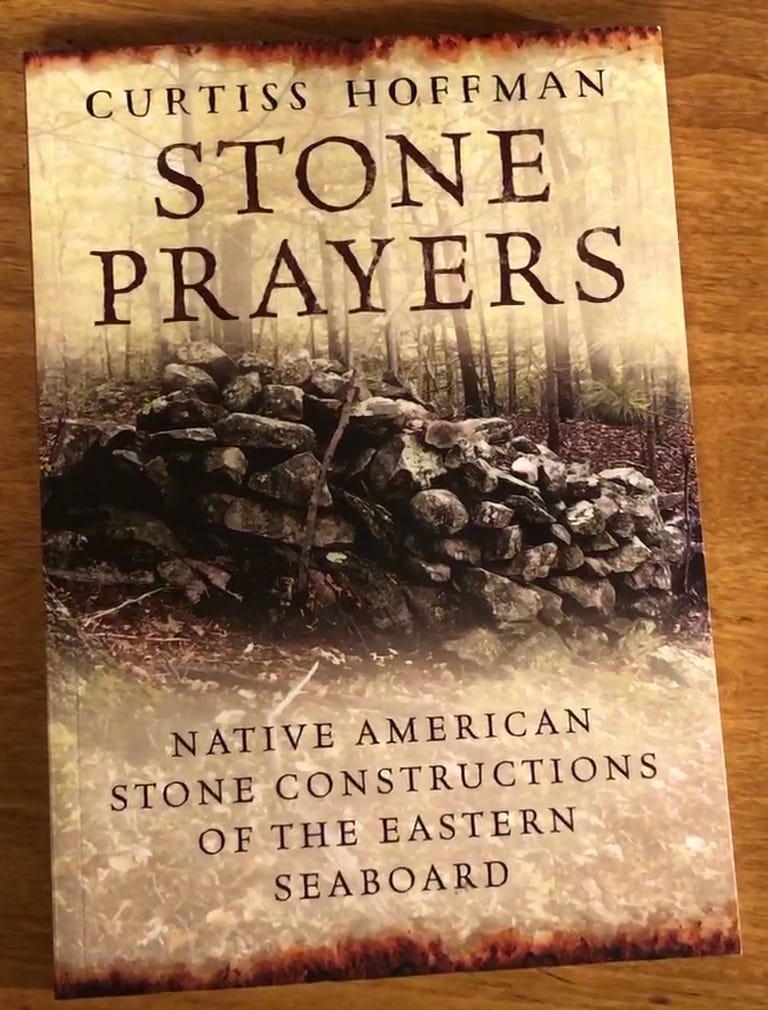
Archeologist Curtis Hoffman, former President of the Massachusetts Archeological Society, and author of Stone Prayers: Native American Stone Constructions Of The Eastern Seaboard, faults colleagues for this scientism regarding the stonework. As Hoffman's 2018 study showed, there are many reasons to believe some of New England's stonework predates Colonial Contact, and mounting evidence much could be originally of indigenous origin. And this includes New England's fabled stone walls.
The indigenous of this area built with stone, likely for ritual as well as practical reasons. We dispelled the old, “Indians around here didn't build with stone,” myth in the original Yankee Lore video. But even some who concede some Cairn-like stone constructs, or stone piles, could be of indigenous ritual origin, can't make the leap and allow that many of New England's stone walls could also be of indigenous origin.
Bonus Content: Raw video of the Stone Row from Boylston, Massachusetts seen in the Video.
New England's Stone Wall Mythology is pretty deeply ingrained. Thank you, Robert Frost. And thank you, Robert Thorson – our current age’s Stone Wall Mythologist – geologist and author of Stone By Stone: The Magnificent History In New England, Stone Walls. Since its 2002 appearance, Thorson has become the authority on all things New England Stone Walls, quoted extensively, his articles and quotations from the book posted and reposted repeatedly over the last 20 years.
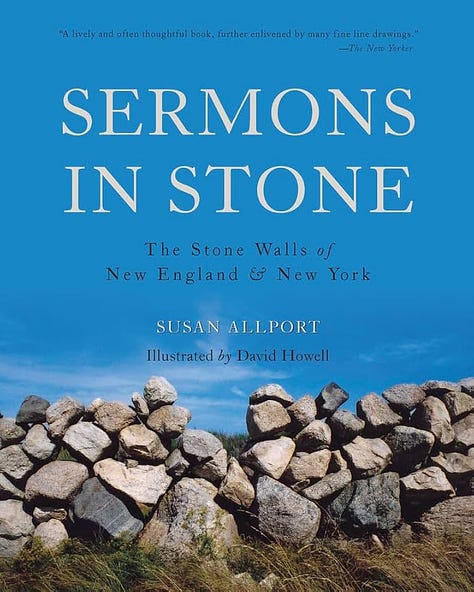
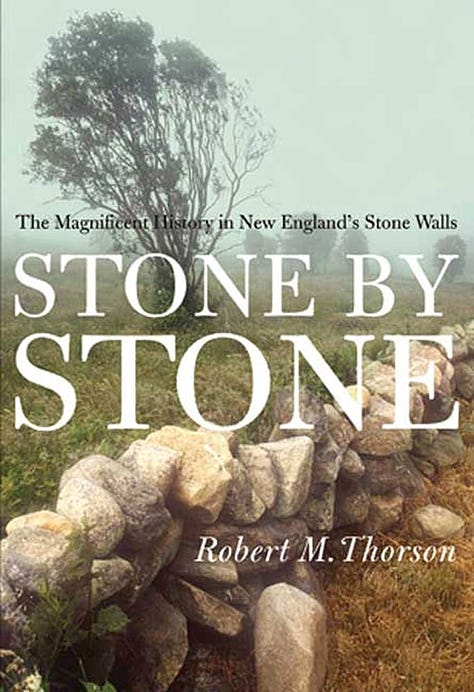
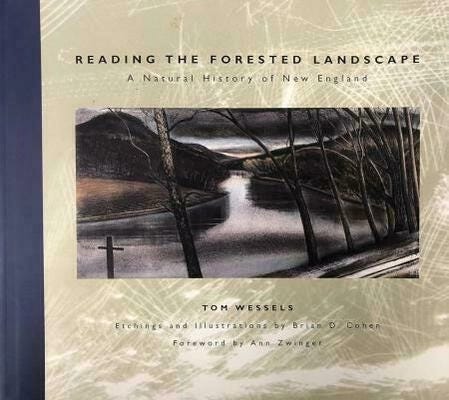
Other so-called Stone Wall Experts, like author Susan Allport of Sermons In Stone, or ecologist Tom Wessels of Reading The Forested Landscape, often quote Thorson as their authority on stone walls. But the scientistic assumptions Thorson presents as science and history are based on Frost's poetry, and the anecdotal recollections of old New Englanders – which are in turn colored by the concepts Frost elevated.
These aren't conclusions based on evidence. It's guesswork based on anecdotes and poetry. And it does not include Indigenous stonework or stone building as a possibility, except in the most dismissive way. Yet, its stone wall guesswork is taken as gospel. Look up stone wall information online, and most searches lead to Thorson.
Thorson originally cited those archeologists who scientistically denied Indigenous stonework. Now, with Thorson’s notoriety, some of those same archeologists cite Thorson, to insist the Indigenous didn't build stone walls. It's gotten very circular.
Beware as well, to those who have done a little armchair research on stone walls by Googling, you may reveal yourself rather quickly by parroting Thorson’s points. But guesswork and assumptions based on anecdotes and poetry aren't evidence. It's Yankee Lore.
Bonus Content: A Slow-Motion Stone Row Walk Along - Extended Footage of a Possible Indigenous Stone Row Near Indian Brook Reservoir in Essex, Vermont, seen in the Video.
Thanks to Frost's poetry and our culture – thanks to Yankee Lore – most people think farmers built New England stone walls and stonework. When you learn that, by 1900, 80% to 90% of New England had been stripped of trees for farming, fuel, and logging, it makes a certain sense to assume that all the old stonework we now see in the woods and forests was once part of old farms and fields.
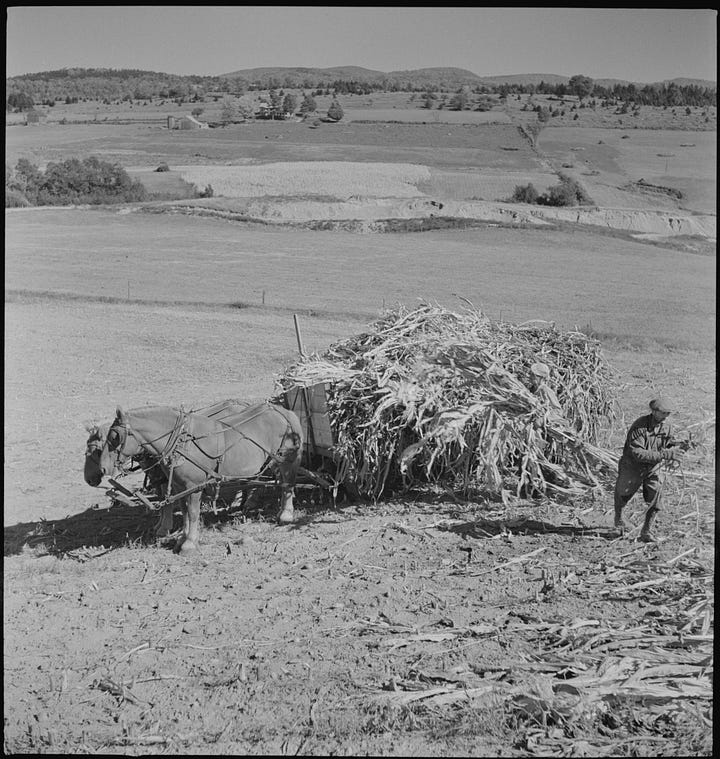
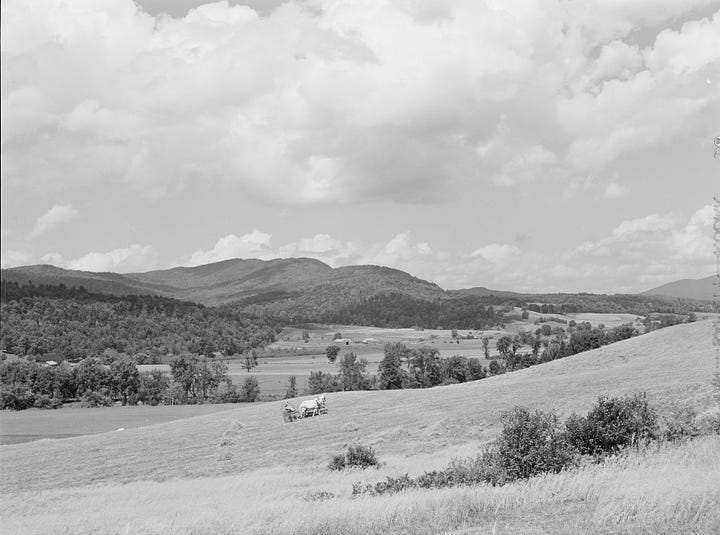
Thorson's work “rhymes” with Frost's poetry, and echoes what some want to hear, reinforcing belief in industrious Yankee ancestors, in sheep farmers building 250,000 miles or more of stone walls in 30 years. Seems entirely plausible to those who lionize those old “men of the soil”, but the population sizes and the math makes it awfully farfetched.
Most skilled stonemasons can lay about 20 feet of dry stone wall in a day. With Sundays off, that's 120 feet a week, around 540 feet a month, and – if we grant a generous building season of almost 10 months – the average skilled stonemason can build about a mile of dry stone wall a year.
The suggestion is that some 250,000 miles of stone walls were built for the Merino sheep craze in about 30 to 50 years. That's at least 5000 miles of stone wall built each year.
So, at highest efficiency, it would require the labor of 5000 skilled stone masons each year, exclusively building stone walls, for a 50-year stretch. We don't know how many thousands more unskilled or semi-skilled farmers and laborers it would take to accomplish this in a similar time frame, as it is impossible to calculate how many feet of stone wall lesser skilled laborers could produce in a set period of time, but it gives us an idea of the scope of the labor involved.
Bonus Content: The Video Shown in the Background as the Facts and Figures are displayed. See It Without Obstruction! This Stone Row is in Williston, Vermont.
How many stone masons were there?
We know, today, thanks to the Bureau of Labor Statistics, that there are only 9790 stone masons in the US, as of 2023. Just 70 in Vermont. And just over 1000 in Massachusetts, though it's second only to California with just over 1500.
We don't have labor statistics for the 1600s. The one reference we do have is Charles H Pope's book Pioneers Of Massachusetts, from 1900, where he lists the occupations of 1725 of about 6000 pioneers, between 1620 and 1650, those occupations he could find record of in contemporary documents. Stone Mason is not included in his list of occupations.
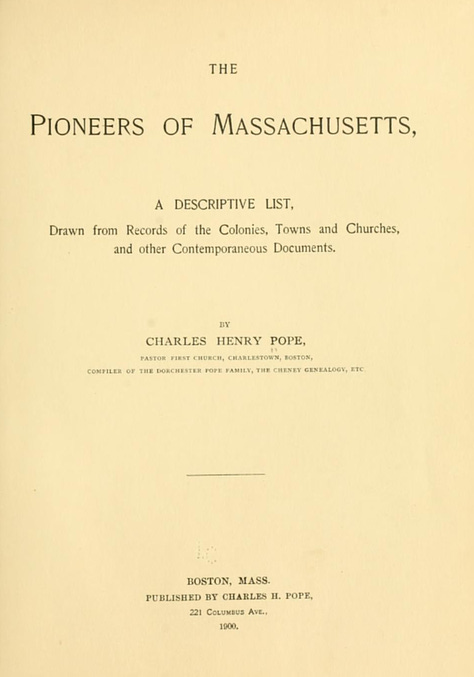
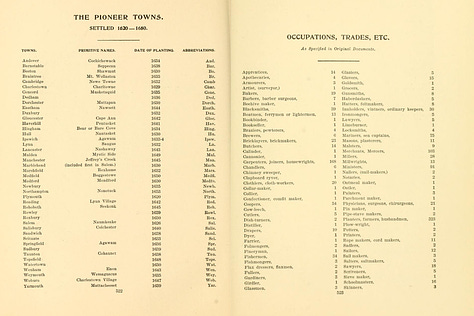
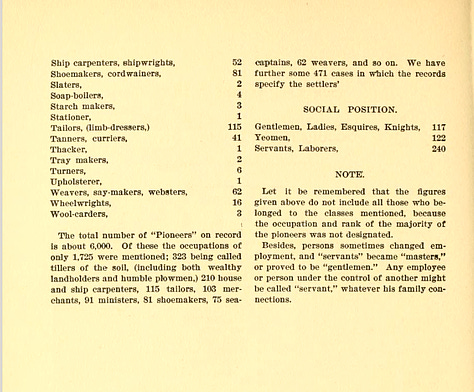
Granted, it's an incomplete list, covering only about a third of the population. But it is a curious omission, with Pope finding no record of stone masons working in New England from 1620 to 1650 (the “Masons, Plasterers” listed are Cement Masons, Plasterers, and not Stone Masons).
Those who say stone walls were all built by early settlers are also pushing another myth from Yankee Lore, the idea, “our people came here from stone-wall-building country, so they began building them here.” It's assumed, even academically, that settlers taught indigenous people they enslaved and employed how to build with stone – again, because “we come from stone building country.”
But there's a simple exercise you can do to see for yourself this just isn't true.
One can only build with stone where there's plenty of stone, which means “stone-building-country” usually sat underneath the ice sheets during the last Ice Age, the glaciers depositing bountiful stones as they melted and retreated, leaving a surplus of building material behind.
Geologists figured out how far south the glaciers came in the last ice age, and charted its furthest extent, called the Last Glacial Maximum. Above this line, we'll find stone-building-country below it, wooden fences.
The earliest settlers of New England most often named their new towns after where they came from in old England. If we overlay the Last Glacial Maximum on a map of England and begin looking at the namesake towns for the earliest New England towns, you notice immediately the majority are towns below that line.
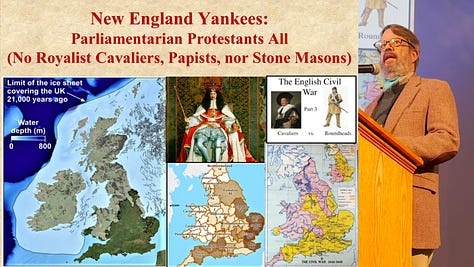
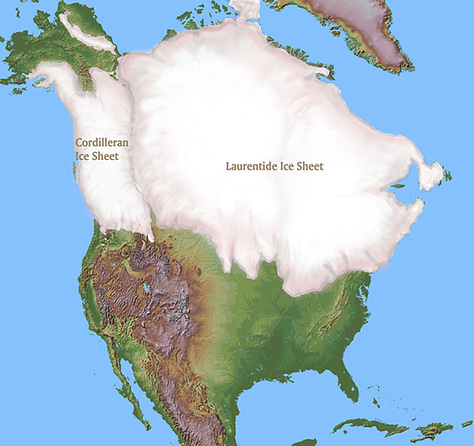
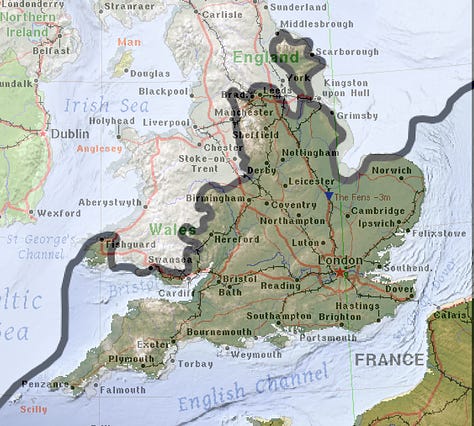
Archeologist Vance Tiede mentioned this as part of a presentation at the Fall Conference of the New England Antiquities Research Association, NEARA, in 2022, citing the work of David Bouchier from A Few Well-Chosen Words. Vance presented population figures that bore this out, but the town names alone give it away.
Of the first 40 towns founded, most in Massachusetts, a few in Connecticut, a handful in New Hampshire and Rhode Island, 31 of them were named for English towns. Only one of those towns is above that line. Two are on the border, but 28 of the 31 towns are South of the Last Glacial Maximum, well outside of stone-building-country. Surprisingly, New England settlers were not stone-wall-building people, despite the assumptions of Yankee Lore.
Bonus Content: Figuring It Out - Mike Luoma’s Notebook Pages from Researching New England’s 40 Earliest Towns.
Keep reading with a 7-day free trial
Subscribe to Ancient Stone Mysteries to keep reading this post and get 7 days of free access to the full post archives.


